
Deposition Date
2023-11-06
Release Date
2023-11-22
Last Version Date
2024-11-20
Entry Detail
PDB ID:
8X0T
Keywords:
Title:
Frizzled8 CRD in complex with pF8_AC3 Fab
Biological Source:
Source Organism:
Homo sapiens (Taxon ID: 9606)
synthetic construct (Taxon ID: 32630)
synthetic construct (Taxon ID: 32630)
Host Organism:
Method Details:
Experimental Method:
Resolution:
2.50 Å
R-Value Free:
0.28
R-Value Work:
0.23
R-Value Observed:
0.23
Space Group:
C 2 2 21


